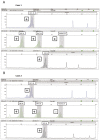Low prevalence of biliary tract cancer with defective mismatch repair genes in a Japanese hospital-based population
- PMID: 34820003
- PMCID: PMC8607234
- DOI: 10.3892/ol.2021.13122
Low prevalence of biliary tract cancer with defective mismatch repair genes in a Japanese hospital-based population
Abstract
Recent studies have reported that immune checkpoint inhibitors are effective against various defective mismatch repair (dMMR)/microsatellite instability-high (MSI-H) cancers. A limited number of reports are available on the frequency of dMMR/MSI-H carcinoma in biliary tract cancer (BTC), describing its clinicopathological characteristics and prognosis. The latter carcinoma is also associated with Lynch syndrome (LS). The present study was performed to investigate the frequency of patients with dMMR/MSI-H in BTC and the clinical characteristics of BTC with dMMR/MSI-H in a single institution in Japan. A total of 116 patients with BTC who underwent curative surgical resection at Kagawa University Hospital between January 2008 and December 2017 were included. The protein expression levels of the mismatch repair (MMR) genes [mutL homolog 1 (MLH1), mismatch repair endonuclease PMS2 (PMS2), MutS homolog (MSH)2 and MSH6] were assessed by immunohistochemistry (IHC) using formalin-fixed paraffin-embedded tissue specimens. Subsequently, MSI testing was performed on patients who exhibited loss of MMR protein expression. Loss of expression of one or more proteins was detected in five cases (4.3%). Loss of MLH1/PMS2 expression was observed in one case of intrahepatic cholangiocarcinoma, whereas loss of PMS2 expression was noted in one case of perihilar cholangiocarcinoma. Loss of MSH2/MSH6 and MSH6 expression was noted in two cases of distal cholangiocarcinoma and loss of PMS2 expression in one case of ampullary carcinoma. Out of the five patients, two demonstrated MSI-H. Microsatellite stability was observed in two cases and for one case, no data were available. Two MSI-H cases were patients with loss of expression of MLH1/PMS2 and MSH2/MSH6. None of the five patients exhibited a past medical history or family history of suspected LS. The frequency of dMMR in BTC was ~5%, which was similar to that reported by similar studies performed in other countries. In the present study, IHC appeared to be more useful than MSI testing for detecting MMR abnormalities with regards to the detection rate. Furthermore, there may only be a limited number of patients with BTCs who are likely to benefit from the therapeutic effects of treatment with immune checkpoint inhibitors.
Keywords: Lynch syndrome; biliary tract cancer; defective mismatch repair; immunohistochemistry; microsatellite instability-high.
Copyright: © Ando et al.
Conflict of interest statement
The authors declare that they have no competing interests.
Figures


Similar articles
-
[Analysis of microsatellite instability in endometroid carcinoma with deficient mismatch repair].Zhonghua Bing Li Xue Za Zhi. 2021 May 8;50(5):470-475. doi: 10.3760/cma.j.cn112151-20210201-00114. Zhonghua Bing Li Xue Za Zhi. 2021. PMID: 33915653 Chinese.
-
[Mismatch repair protein expression of colorectal cancer: a retrospective analysis of 3 428 cases].Zhonghua Bing Li Xue Za Zhi. 2021 Apr 8;50(4):369-375. doi: 10.3760/cma.j.cn112151-20200731-00608. Zhonghua Bing Li Xue Za Zhi. 2021. PMID: 33831997 Chinese.
-
Mismatch repair deficiency screening in colorectal carcinoma by a four-antibody immunohistochemical panel in Pakistani population and its correlation with histopathological parameters.World J Surg Oncol. 2017 Jun 26;15(1):116. doi: 10.1186/s12957-017-1158-8. World J Surg Oncol. 2017. PMID: 28651545 Free PMC article.
-
Universal endometrial cancer tumor typing: How much has immunohistochemistry, microsatellite instability, and MLH1 methylation improved the diagnosis of Lynch syndrome across the population?Cancer. 2019 Sep 15;125(18):3172-3183. doi: 10.1002/cncr.32203. Epub 2019 May 31. Cancer. 2019. PMID: 31150123 Review.
-
ESMO recommendations on microsatellite instability testing for immunotherapy in cancer, and its relationship with PD-1/PD-L1 expression and tumour mutational burden: a systematic review-based approach.Ann Oncol. 2019 Aug 1;30(8):1232-1243. doi: 10.1093/annonc/mdz116. Ann Oncol. 2019. PMID: 31056702
Cited by
-
Clinical characteristics of pancreatic and biliary tract cancers in Lynch syndrome: A retrospective analysis from the Finnish National Lynch Syndrome Research Registry.Front Oncol. 2023 Feb 1;13:1123901. doi: 10.3389/fonc.2023.1123901. eCollection 2023. Front Oncol. 2023. PMID: 36816932 Free PMC article.
-
Targeted Therapies in Advanced Cholangiocarcinoma.Life (Basel). 2023 Oct 16;13(10):2066. doi: 10.3390/life13102066. Life (Basel). 2023. PMID: 37895447 Free PMC article. Review.
-
Long-Term Survival of a Lynch Syndrome Patient With Eight Primary Tumors: A Case Report.Front Oncol. 2022 May 10;12:896024. doi: 10.3389/fonc.2022.896024. eCollection 2022. Front Oncol. 2022. PMID: 35619908 Free PMC article.
-
Clinical features of biliary tract cancer in Japanese individuals with Lynch syndrome.J Gastrointest Oncol. 2022 Oct;13(5):2532-2538. doi: 10.21037/jgo-22-165. J Gastrointest Oncol. 2022. PMID: 36388648 Free PMC article.
-
Lacking Immunotherapy Biomarkers for Biliary Tract Cancer: A Comprehensive Systematic Literature Review and Meta-Analysis.Cells. 2023 Aug 19;12(16):2098. doi: 10.3390/cells12162098. Cells. 2023. PMID: 37626908 Free PMC article.
References
LinkOut - more resources
Full Text Sources
Miscellaneous
